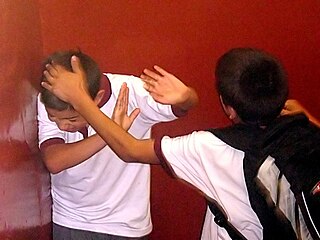
A school is both the educational institution and building designed to provide learning spaces and learning environments for the teaching of students under the direction of teachers. Most countries have systems of formal education, which is sometimes compulsory. In these systems, students progress through a series of schools that can be built and operated by both government and private organization. The names for these schools vary by country but generally include primary school for young children and secondary school for teenagers who have completed primary education. An institution where higher education is taught is commonly called a university college or university.

A school uniform is a uniform worn by students primarily for a school or otherwise an educational institution. They are common in primary and secondary schools in various countries.

The Columbine High School massacre, commonly referred to as Columbine, was a school shooting and attempted bombing that occurred on April 20, 1999, at Columbine High School in Columbine, Colorado, United States. The perpetrators, twelfth-grade students Eric Harris and Dylan Klebold, murdered twelve students and one teacher. Ten of the twelve students killed were in the school library, where Harris and Klebold subsequently committed suicide. Twenty-one additional people were injured by gunshots, and gunfire was also exchanged with the police. Another three people were injured trying to escape. The Columbine massacre was the deadliest mass shooting at a K-12 school in U.S. history, until it was surpassed by the Sandy Hook Elementary School shooting in December 2012, and later the Uvalde school shooting in May 2022, and the deadliest mass shooting at a high school in U.S. history until the Parkland high school shooting in February 2018. Columbine still remains both the deadliest mass shooting and the deadliest school shooting to occur in the U.S. state of Colorado.

A school shooting is an armed attack at an educational institution, such as a primary school, secondary school, high school or university, involving the use of a firearm. Many school shootings are also categorized as mass shootings due to multiple casualties. The phenomenon is most widespread in the United States, which has the highest number of school-related shootings, although school shootings have taken place elsewhere in the world.

Closed-circuit television (CCTV), also known as video surveillance, is the use of video cameras to transmit a signal to a specific place, on a limited set of monitors. It differs from broadcast television in that the signal is not openly transmitted, though it may employ point-to-point (P2P), point-to-multipoint (P2MP), or mesh wired or wireless links. Even though almost all video cameras fit this definition, the term is most often applied to those used for surveillance in areas that require additional security or ongoing monitoring.

Uvalde County is a county located in the U.S. state of Texas. As of the 2020 census, its population was 24,564. Its county seat is Uvalde. The county was created in 1850 and organized in 1856. It is named for Juan de Ugalde, the Spanish governor of Coahuila. Uvalde County was founded by Reading Wood Black, who also founded the city of Uvalde, Texas. Uvalde County comprises the Uvalde, TX Micropolitan Statistical Area.

Home security includes both the security hardware placed on a property and individuals' personal security practices. Security hardware includes doors, locks, alarm systems, lighting, motion detectors, and security camera systems. Personal security involves practices like ensuring doors are locked, alarms are activated, owning a Dog, windows are closed, and extra keys are not hidden outside.
Uvalde Consolidated Independent School District (UCISD) is a public school district based in Uvalde, Texas, US. Located in Uvalde County, the district extends into portions of Zavala and Real counties. In addition to Uvalde, the district serves the communities of Batesville in Zavala County, and Uvalde Estates in Uvalde County. The total land area of the district is 1,093 square miles (2,830 km2).

School bullying, like bullying outside the school context, refers to one or more perpetrators who have greater physical strength or more social power than their victim and who repeatedly act aggressively toward their victim. Bullying can be verbal or physical. Bullying, with its ongoing character, is distinct from one-off types of peer conflict. Different types of school bullying include ongoing physical, emotional, and/or verbal aggression. Cyberbullying and sexual bullying are also types of bullying. Bullying even exists in higher education. There are warning signs that suggest that a child is being bullied, a child is acting as a bully, or a child has witnessed bullying at school.
Anti-bullying legislation is a legislation enacted to help reduce and eliminate bullying. This legislation may be national or sub-national and is commonly aimed at ending bullying in schools or workplaces.

Mass surveillance in the People's Republic of China (PRC) is the network of monitoring systems used by the Chinese central government to monitor Chinese citizens. It is primarily conducted through the government, although corporate surveillance in connection with the Chinese government has been reported to occur. China monitors its citizens through Internet surveillance, camera surveillance, and through other digital technologies. It has become increasingly widespread and grown in sophistication under General Secretary of the Chinese Communist Party (CCP) Xi Jinping's administration.
A mantrap, security mantrap portal, airlock, sally port or access control vestibule is a physical security access control system comprising a small space with two sets of interlocking doors, such that the first set of doors must close before the second set opens. Airlocks have a very similar design, allowing free ingress and egress while also restricting airflow.

The 2017 Aztec High School shooting was a school shooting and murder-suicide perpetrated by 21-year-old former student William Atchison on December 7, 2017, in Aztec, New Mexico, United States. Atchison entered the school in the morning disguised as a student and hid in the school restroom. He was discovered before he could launch a major attack, but fatally shot two students before killing himself. Investigators believe that the quick actions of the teachers in barricading doors to the classrooms helped prevent mass casualties.

Andrew Scott Pollack is an American author, school safety activist, and entrepreneur whose daughter Meadow was one of the 17 murdered victims in the Stoneman Douglas High School shooting in 2018.
The Federal Commission on School Safety or School Safety Commission is a council of members of the Cabinet of the United States formed in March 2018, in the wake of the Stoneman Douglas High School shooting the previous month, to address gun violence in schools.

Active shooter training addresses the threat of an active shooter by providing awareness, preparation, prevention, and response methods.

The Uvalde school shooting was a mass shooting that occurred on May 24, 2022, at Robb Elementary School in Uvalde, Texas, United States, when 18-year-old Salvador Ramos, a former student at the school, fatally shot 19 students and two teachers, while 17 others were injured but survived. After shooting and severely wounding his grandmother at their home earlier that day, Ramos drove to and entered the school, remaining in an adjoining classroom for more than an hour before members of the United States Border Patrol Tactical Unit fatally shot him after they bypassed numerous local and state officers who had been in the school's hallways for over an hour.

Uvalde High School is a public high school for grades 9–12 in Uvalde, Texas, in the United States. It has a current enrollment of about 1,250 students. The school is part of the Uvalde Consolidated Independent School District. The school is 90.4% Hispanic as of the 2022-2023 school year.
Arming teachers is equipping teachers in preschool through secondary school with firearms with the intent to prevent casualties from school shootings. Such proposals have engendered public debate regarding with whom the responsibility for providing a safe environment lies, and whether it would reduce or escalate the risk of shootings. School shootings, and proposals to arm teachers, are most common in the United States, but proposals have also been made in countries such as Israel, Kenya, Pakistan, South Africa, and Thailand.
Gun violence is the leading cause of death for children and teens under the age of 20 in the United States. Since the Columbine High School shooting in 1999, there have been 394 cases of gun violence in schools. The frequency of school shootings increased dramatically after 2018, with a slight decrease in 2020 during the early part of the Covid-19 pandemic.














